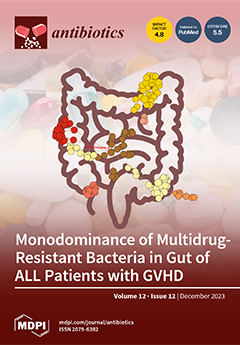(1) Background: The widespread use of MALDI-TOF coupled to mass spectrometry has improved diagnostic accuracy by identifying uncommon bacteria. Among Enterobacterales,
Pantoea species have been seen to be implicated in several human infections, but their clinical and microbiological framework is currently based on
[...] Read more.
(1) Background: The widespread use of MALDI-TOF coupled to mass spectrometry has improved diagnostic accuracy by identifying uncommon bacteria. Among Enterobacterales,
Pantoea species have been seen to be implicated in several human infections, but their clinical and microbiological framework is currently based on a few anecdotal reports. (2) Methods: We conducted this five-year (2018–2023) single-center study aimed at investigating the prevalence and clinical and microbiological findings of
Pantoea species bloodstream infections. (3) Results: Among the 4996 bloodstream infection Gram-negative isolates collected during the study period,
Pantoea species accounted for 0.4% (n = 19) of isolates from 19 different patients, 5 of them being pediatric cases. Among
Pantoea species isolates,
P. agglomerans was the most frequently detected (45%; n = 9) followed by
P. eucrina (30%; n = 6) and
P. septica (15%; n = 3). Malignancy (35.7%) in adults and malignancy (40%) and cerebrovascular disease following meconium aspiration (40%) in pediatric patients as comorbidities and shivering and/or fever following parenteral infusion (36.8%) as a symptom/sign of
Pantoea species bloodstream infection onset were the most frequently observed clinical features. Among adults, primary bloodstream infection was the most frequent (50%), whereas among pediatric patients, the most commonly identified sources of infection were catheter-related (40%) and the respiratory tract (40%). Overall,
Pantoea species bloodstream infection isolates displayed high susceptibility to all the antibiotics except for ampicillin (63.2%), fosfomycin (73.7%), and piperacillin/tazobactam (84.2%). Targeted antibiotic treatment was prescribed as monotherapy for adults (71.4%) and combination therapy for pediatric patients (60%). The most prescribed antibiotic regimens were piperacillin/tazobactam (21.4%) in adults and meropenem- (40%) and aminoglycoside-containing (40%) antibiotics in pediatric patients. The overall 28-day all-cause mortality rate was 5.3% (n = 1). (4) Conclusions: The prevalence and 28-day mortality rate of
Pantoea species bloodstream infections were low. The prescription of targeted therapy including broad-spectrum antibiotics could indicate an underestimation of the specific involvement of the
Pantoea species in the onset of the disease, warranting further studies defining their pathogenic potential.
Full article






